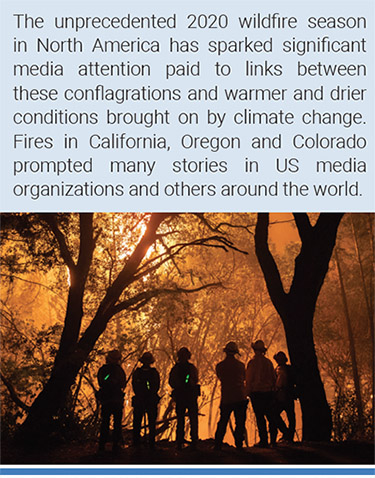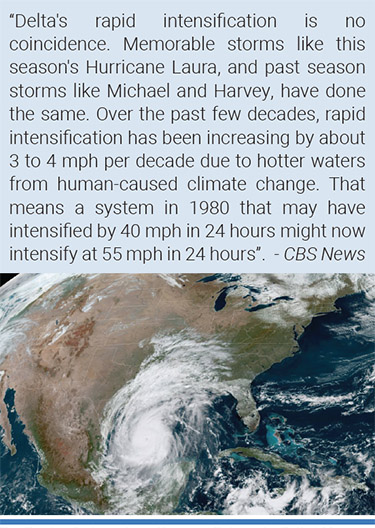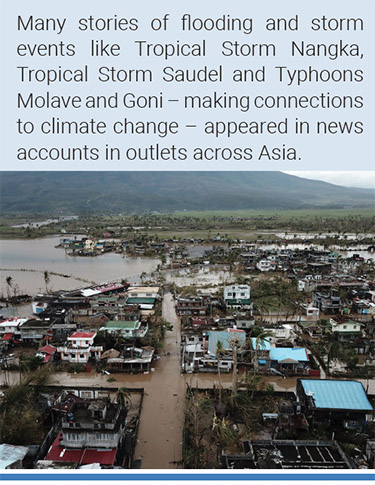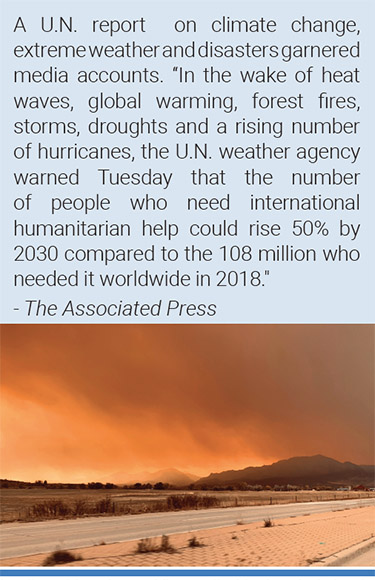Monthly Summaries
Issue 46, October 2020
[DOI]

Built in 1906, this is the abandoned Glenwood Power Station in New York. Photo: Will Ellis.

October 2020 was another month where media coverage of climate change or global warming continue to rebound in terms of frequency of coverage since the low levels detected earlier in 2020. October media attention increased globally by 2% from September 2020. Nonetheless, coverage was still down 30% from coverage a year ago (October 2019). Figure 1 shows trends in newspaper media coverage at the global scale – organized into seven geographical regions around the world – January 2004 through October 2020.

Figure 1. Newspaper media coverage of climate change or global warming in print sources in seven different regions around the world, from January 2004 through October 2020.
Firefighters battle the Glass Fire as it encroaches towards a residence in Calistoga, California, on October 1. Photo: Adrees Latif/Reuters. |
Regionally, October 2020 coverage increased from the previous month of September by 21% in Oceania, 24% in Asia, 32% in Latin America and 36% in the Middle East, while decreasing 5% in Europe and 12% in North America. Coverage held steady in Africa. At the country level, media coverage of climate change increased in Japan (+29%), India (+37%), New Zealand (+45%), Norway (+11%), Russia (+42%), Spain (+10%) and Australia (+5%) in October 2020 from September 2020. Meanwhile, October 2020 coverage decreased in Canada (-26%), Denmark (-10%), Germany (-18%), Sweden (-10%), the United Kingdom (-10%) and the United States (US) (-1%) from September 2020.
Moving to the content of coverage, in October ecologicaland meteorological themes continued to dominate news stories connecting events and a changing climate. Among these developments, the unprecedented 2020 wildfire season in North America has sparked significant media attention paid to links between these conflagrations and warmer and drier conditions brought on by climate change. Fires in California, Oregon and Colorado prompted many stories in US media organizations and others around the world.
For example, Associated Press correspondent Jocelyn Gecker reported for PBS Newshour that “Deadly wildfires in California have burned more than 4 million acres (6,250 square miles) this year — more than double the previous record for the most land burned in a single year in the state. California fire officials said the state hit the astonishing milestone Sunday with about two months remaining in the fire season. The previous record was set two years ago when wildfires destroyed 1.67 million acres (2,609 square miles)... Many of the most destructive fires sparked in Northern California, where hills and mountains dotted with many dead trees have provided plenty of fuel for fires igniting amid high temperatures and strong winds fanning the flames. Thick, gray smoke from the blazes has fouled the air in many hill communities and major cities in the San Francisco Bay Area and beyond. Numerous studies have linked bigger wildfires in America to climate change from the burning of coal, oil and gas. Scientists say climate change has made California much drier, meaning trees and other plants are more flammable”. Meanwhile, Los Angeles Times journalists Alex Wigglesworth and Joseph Serna noted, “Lightning in August ignited many of California’s biggest blazes, but scientists say climate change has also contributed to the conflagrations. It was the hottest August on record in California, and trees and brush were already abnormally dry and combustible after Northern and Central California saw exceptionally dry conditions last winter”.
Chronologically intertwined in unfolding ecologically- and meteorologically-themed climate change coverage, stories of hurricanes making landfall in the Caribbean Basin and US Gulf Coast also flooded the public arena.To illustrate, journalist Jeff Berardelli from CBS News reported, “Delta's rapid intensification is no coincidence. Memorable storms like this season's Hurricane Laura, and past season storms like Michael and Harvey, have done the same. Over the past few decades, rapid intensification has been increasing by about 3 to 4 mph per decade due to hotter waters from human-caused climate change. That means a system in 1980 that may have intensified by 40 mph in 24 hours might now intensify at 55 mph in 24 hours”. Meanwhile, Associated Press reporter Seth Borenstein noted, “Since 1982, the proportion of storms that rapidly intensify in the Atlantic has come close to around doubling, according to a study last year by Kossin and a team out of Princeton University. This year is particularly nasty and Delta is a good example, said study co-author Gabriel Vecchi, a Princeton climate scientist. That study also found this type of growing trend of rapid intensification cannot be explained by natural forces. Vecchi and Kossin said climate change, from the burning of coal, oil and natural gas, is clearly playing a major role. That’s because two factors are key in storms getting stronger and weaker: fuel from hot water — and the type and direction of winds high up that have the potential for decapitating hurricanes or letting them get more powerful”.
This October 8 photo shows Hurricane Delta in the Gulf of Mexico at 12:41 PM EDT. Photo: NOAA via AP. |
In October many stories of flooding and storm events like Tropical Storm Nangka, Tropical Storm Saudel and Typhoons Molave and Goni – making connections to climate change – appeared in news accounts in outlets across Asia. For example, a report from The Indian Express noted, “India is leading a delegation of nations, including Bhutan, Sri Lanka, Bangladesh and Nepal, in sharing hydrological and meteorological data towards preparing flash flood forecasts...the frequency of extreme rainfall events has increased due to climate change and South Asia is highly prone to flash floods”. As another example, reporter Jiseok Kim posited in The South China Morning Post “according to the Intergovernmental Panel on Climate Change special report on the ocean, sea ice and glaciers, extreme sea level events that occurred once per century in the past in many coastal regions will become more frequent, perhaps even annual occurrences for many low-lying coastal areas by 2050. Will leaders in East Asia be able to deal with future floods that are bound to intensify due to accelerating global warming?” And journalist Nina Larson wrote a piece appearing in The Jakarta Post noting that the United Nations said “Global temperatures boosted by climate change will still be higher than usual despite the cooling effect of a "moderate to strong" La Nina weather phenomenon”. As an example of international media attention, in a story about Typhoon Molave New York Times journalist Yan Zhuang noted, “Before it moved west to Vietnam, the typhoon killed 16 people in the Philippines over the weekend, according to local news reports. Scientists say that global warming is fueling more frequent and more catastrophic storms and flooding across the world”. As an example of international media attention to Typhoon Goni at the end of the month, New York Times journalists Hannah Beech and Jason Gutierrez commented, “climate change is exacerbating the Philippines’ exposure to natural disasters, making it one of the most vulnerable countries on the planet”.
Flooding and destruction in Malinao, south of Manila. Photo: Charism Sayat/Agence France-Presse. |
Later in October, the ongoing Atlantic hurricane season continued to draw attention to global warming and climate change. The impacts from hurricane Epsilon and hurricane Zeta, in particular, drove coverage. For example, Washington Post journalist Matthew Cappucci reported, “Hurricane Epsilon rapidly intensified Tuesday and Wednesday, unexpectedly becoming a major Category 3 hurricane and claiming two records as it cruised northwest over the open Atlantic...It surprised meteorologists when it intensified into Category 3 major hurricane with 115 mph winds on Wednesday afternoon. That significantly exceeds the criterion for “rapid intensification” of 35 mph or more in 24 hours. Epsilon jumped at least 50 mph in that same time frame... Rapid intensification is probably a product of warming waters in the face of climate change. And more storms are likely to undergo rapid intensification in the future, presenting predictive challenges to meteorologists”.
A week later, Associated Press journalists Kevin McGill, Stacey Plaisance and Rebecca Santana reported, “Hurricane Zeta slammed into the storm-weary Gulf Coast on Wednesday, pelting the New Orleans metro area with rain and howling winds that ripped apart buildings and knocked out power to thousands before rapidly making its way through Mississippi and Alabama with strong gusty winds, heavy rains and dangerous storm surge... An average season sees six hurricanes and 12 named storms. This extraordinarily busy season has focused attention on climate change, which scientists say is causing wetter, stronger and more destructive storms”.
In late October, further wildfire activity across the US West influenced media coverage connecting these fiery dots with a changing climate. For example, Washington Post journalist Andrew Freedman reported, “Scientific studies show that by increasing air temperatures and drying out soils and vegetation, climate change increases the frequency and severity of days with extreme fire risk. This is true in the West, but also in other parts of the world”.
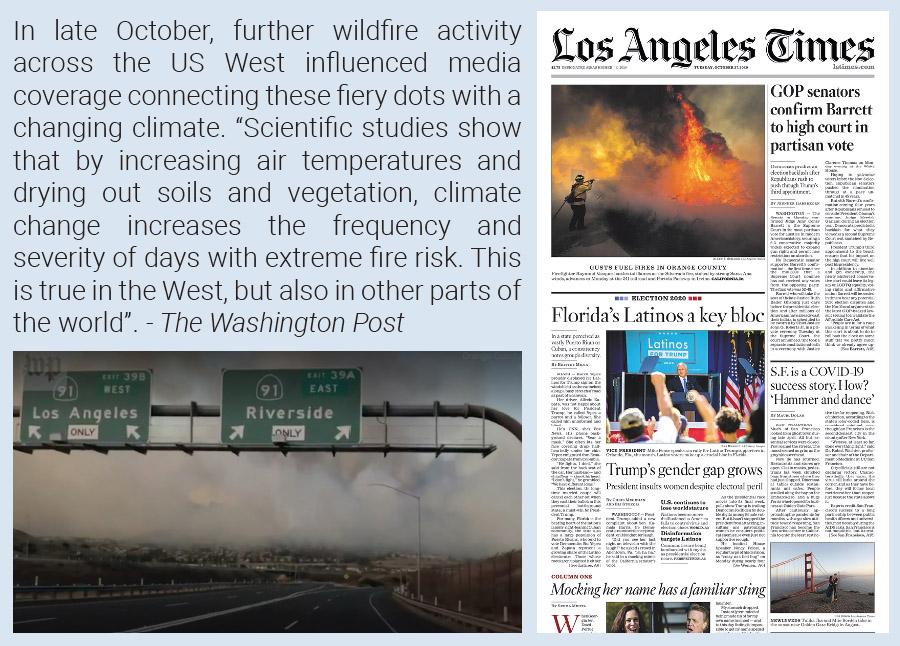
Figure 2. Font page coverage of California wildfires in October 27, 2020 in the Los Angeles Times with links made to a changing climate. Photo above: Orange County Fire Authority have been fighting a fire in Irvine, California, that started on October 26. Credit: Monica Rodman/The Washington Post.
These ecological and meteorological stories then fed into political and economic media coverage of climate change or global warming in October. The changing climate stances of big banks, for instance, generated media attention. For example, Wall Street Journal correspondent David Benoit reported, “The U.S. is pulling out of the Paris climate accord, but the biggest U.S. bank is committing to it. JPMorgan Chase & Co. is pledging to use its financing weight to push clients to align with the Paris agreement and work toward global net zero-emissions by 2050. The bank said it would invest in technologies that help reduce carbon emissions and will work with clients to cut their own carbon footprints. JPMorgan’s bankers and advisers hold considerable sway in boardrooms around the globe. The bank plans to argue to clients that combating climate change opens the door to more capital from investors and reduces their risk of becoming outdated. Other banks have made various pledges to stop supporting Arctic drilling and coal companies. British banks NatWest Group PLC (the former RBS Group PLC) and Barclays PLC have both committed to using their business to further the Paris agreement, the 2015 deal that called on global governments to curb rising temperatures. Citigroup Inc. earlier this year said it would walk away from clients that aren’t taking climate change seriously”.
Coalminers descend underground at a mine operated by Beijing Haohua Energy Resource. Photo: Ni Shaokang/VCG. |
Also in October, China followed on President Xi Jinping’s strong rhetoric on climate policy action at the UN General Assembly in September with critiques of US climate policy action. This manifested in a ‘factsheet’ from the Chinese Ministry of Foreign Affairs accusing the Trump Administration of undermining global climate governance and cooperation. The US State department replied with its own ‘China’s Environmental Abuses Fact Sheet’. This back-and-forth attracted media attention. For example, Washington Post journalist Steven Mufson reported, “China delivered a diatribe against U.S. climate policies... saying that under President Trump, the United States “is widely viewed as a consensus-breaker and a troublemaker.” Beijing’s Foreign Affairs Ministry blamed Trump’s “negative stance” and “retrogression on climate change” for undermining progress on an international climate accord. Trump, who plans to formally pull out of the Paris climate agreement the day after Election Day, had “seriously undermined the fairness, efficiency and effectiveness of global environmental governance,” the ministry said in a fact sheet. The barrage from Beijing resembled the tit-for-tat criticism that China and the United States have traded on subjects such as human rights, trade and the expulsion of reporters and diplomats, but climate policies have been largely the exception. Not anymore”.
In other political developments, media sources in Japan generated stories on new Japanese minister Suga’s announcement of a new long-term carbon reduction target. For example, an Asahi Shimbun report noted, “Prime Minister Yoshihide Suga declared in his statement on the 26th that he would aim for virtually zero greenhouse gas emissions by 2050. This goal is the path of reduction needed to keep the global average temperature rise to 1.5 degrees Celsius compared to before the Industrial Revolution”. Meanwhile, reporting Yomiuri Shimbun observed, “Although emissions have been curtailed due to the economic stagnation caused by the spread of the new coronavirus infection, attention is being paid to what will happen with the economic recovery after the infection has subsided” while a piece in Mainichi Shimbun commented that the Japanese government “will request companies and others to further strengthen their measures”. Also in Japan in October, Environment minister Koizumi generated media attention as he talked about the promotion of post-carbon policies. For example, journalists Toru Ishii, Akemi Kanda, and Rokumi Mitobe from Asahi Shimbun reported, “Behind the fact that Prime Minister Yoshihide Suga set a net zero greenhouse gas in 2050, there is also the fact that he may be left behind in the international decarbonization trend. The government is appealing its stance of aiming for realization through technological innovation, but there are many issues that are difficult to judge, such as how to balance renewable energy and nuclear power plants and how much to limit coal-fired power”.

Figure 3. Japanese newspaper media coverage of climate change or global warming in Asahi Shimbun, Yomiuri Shimbun, and Mainichi Shimbun from January 2004 through October 2020.
There were also many media stories about scientific research and findings about aspects of climate change or global warming in October. Early in the month, a UN report on climate change, extreme weather and disasters garnered media accounts. For example, Associated Press correspondent Jamey Keaten reported, “In the wake of heat waves, global warming, forest fires, storms, droughts and a rising number of hurricanes, the U.N. weather agency warned Tuesday that the number of people who need international humanitarian help could rise 50% by 2030 compared to the 108 million who needed it worldwide in 2018. In a new report released with partners, the World Meteorological Agency says more disasters attributed to weather are taking place each year. It said over 11,000 disasters have been attributed to weather, climate and phenomena like tsunamis that are related to water over the last 50 years — causing 2 million deaths and racking up $3.6 trillion worth of economic costs. In one hopeful development over that period, the average number of deaths from each separate weather disaster per year has dropped by one-third, even as the number of such events and the economic costs from them have both surged. The 2020 State of Climate Services report, compiled by 16 international agencies and financing institutions, calls on governments to put more money into early-warning systems that can improve countries’ ability to prepare for, respond to and mitigate the impact of such natural disasters”.
Smoke and haze from wildfires in Boulder County, Colorado. Photo: Ami Nacu-Schmidt. |
In mid-October the annual report from the International Energy Agency – assessing carbon-based and renewable energy generation – made a splash in the media. For example, in an article entitled ‘Coronavirus Pandemic Speeds Shift to Cleaner Energy’ journalists Russell Gold and David Houdari from The Wall Street Journal wrote, “The world’s transition to cleaner sources of energy is gaining speed as the coronavirus pandemic accelerates a shift in investment away from fossil fuels, according to the International Energy Agency. Capital spending on energy this year is set to plunge by 18%, as global energy demand is expected to fall by 5% in 2020, a pullback not seen since World War II, the Paris-based agency said in its annual report on the future of the industry. But the projected investment cuts are highly uneven, highlighting a divergence in what companies, markets and investors are willing to finance. Spending on new oil and gas supplies took the largest hits, while renewable energy held up better than any other source, the IEA found. The pandemic weakened corporate balance sheets and increased uncertainty over future fuels demand, spurring the record cuts. Solar- and wind-energy projects are benefiting from falling costs, as well as widespread government support, and monetary policies that support low interest rates. The IEA expects renewables to provide 80% of the growth in global electricity demand through 2030”. Furthermore, CNN reported Hanna Ziady noted, “Renewable energy, led by solar power, could make up 80% of the growth in electricity generation over the next decade…The International Energy Agency said it is now consistently cheaper to generate electricity by capturing the sun's energy than by burning coal or natural gas in most countries. Solar photovoltaic cells are now one of the cheapest sources of electricity in history thanks to maturing technologies and policies that have reduced the cost of investments...While fossil fuels face a precarious future, the prospects for renewable sources of power generation range from "strong to spectacular," with solar leading the charge”.
People march at around the White House and Black Lives Matter Plaza in Washington, DC. Photo: Rodney Choice/Associated Press. |
Last, cultural– while much less prominent in media accounts than in the previous month of September – continued to appear in climate change or global warming stories in October. For example, journalist Tim Wyatt from The Independent (London) reported, “BBC staff will normally be allowed to attend Pride marches, the director general has confirmed, after a day of speculation and anger at new impartiality guidelines” but journalists are told to “use own judgement on Black Lives Matter or climate change protests”. Meanwhile, in the context of the November 3 US presidential election journalist Michelle Ye Hee Lee from The Washington Post commented, “Major social movements driven by young activists around climate change, gun safety and Black Lives Matter protests have led to an explosion of civic awareness among younger Americans, who are on track to turn out to vote in record numbers this election and could play a pivotal role in some key battleground states”. Yet protests and demonstrations about climate change by groups such as ‘Extinction Rebellion’ and ‘Fridays for Future’ continued to generate media attention in outlets such as The Guardian and the BBC.
This month MeCCO tracked the word usage stemming from the May 2019 style guide shift in The Guardian from using the terms ‘global warming’ or ‘climate change’ to using ‘global heating’ or ‘climate emergency’ or ‘climate crisis’ or ‘climate breakdown’. We compared the coverage of these terms as well as these terms combined with ‘climate change’ or ‘global warming’. We then compared coverage with ‘climate change’ or ‘global warming’ coverage in The New York Times as well as Times of London (Figure 4).
Figure 4. Coverage of ‘climate crisis’ or ‘climate emergency’ or ‘climate breakdown’ or ‘global heating’ in The Guardian and Observer compared to coverage of ‘climate change’ or ‘global warming’ in The Times of London and The New York Times as well as the The Guardian and Observer from Jan. 2019 through Oct. 2020. These trends are then compared with combined The Guardian and Observer of ‘climate change’ or ‘global warming’ or ‘climate crisis’ or ‘climate emergency’ or ‘climate breakdown’ or ‘global heating’ (noting that combined coverage is not a simple aggregate of the previous searches as some stories carried multiple terms in the same piece).
We in the Media and Climate Change Observatory (MeCCO) continue to serve you through our work monitoring media coverage of intersecting dimensions and themes associated with climate change and global warming. If you find our resources valuable, please consider contributing to support our ongoing efforts.

